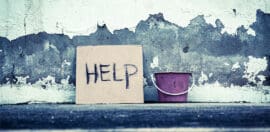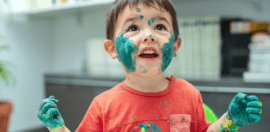Crisis with a child’s face: Why children are the hidden victims of the COVID-19 pandemic

17 January 2022 at 5:54 pm
While all the attention has been on the health impacts of adults during the pandemic, more and more research is revealing children as the hidden victims of the virus, write Mercy Jumo and Dane Moores.
COVID-19 is often considered a pandemic of adults. Indeed, medically speaking, the direct health impacts of COVID-19 are most severe among the elderly, and least severe among children. When it comes to the broader social impacts of the pandemic, however, children are among the most affected.
In the latter half of 2020, World Vision surveyed more than 750 households across four Pacific countries on the socio-economic impacts of COVID-19. And, in 2021, World Vision conducted a similar survey of more than 6,400 households in nine countries across Asia.
The key insight from both pieces of research is that COVID-19 acts as a threat multiplier for children in the region, amplifying risks of violence, child labour, child marriage and other forms of harm. While the world’s attention is on the health and livelihoods of adults in the wake of COVID-19, children are suffering some of the harshest secondary impacts of the pandemic.
Even before COVID-19, children in the Asia-Pacific region faced serious protection risks. As many as 70 per cent (or four million) children across eight Pacific countries experienced violent discipline at home. When we look at the Asia-Pacific region more broadly, we know violence against children cost the economy $US209 billion every year – or 2 per cent of the region’s GDP. The number of working children in the Asia-Pacific is by far the largest in the world.
COVID-19 and its aftershocks are making the situation even worse, adding financial, emotional and social stresses to households which, in many cases, increases risks to children’s safety. Lockdown measures restricted children to the home, reducing opportunities for them to access information and already underfunded health, legal and protection services.
Schools – which serve as a source of education but also as a space of safety and visibility for children – closed for extended periods, making it difficult for teachers to account for children during lockdown and identify early warning signs of harm or absenteeism.
In the Pacific region, the economic fallout caused by COVID-19 is having significant knock-on effects for children. World Vision’s research found 14 per cent of surveyed families sent children to work to supplement income, 14 per cent sent children to beg, and 1.5 per cent resorted to early marriage.
One in three households reported skipping meals and/or reducing portion sizes, which has a disproportionate effect on children because they have a greater need for nutrients and become undernourished faster than adults. Violence against children is also increasing, with 80 per cent of parents or caregivers using physical punishment and/or psychological aggression against their children during this period of increased stress.
It is a similar story in Asia, but on a much larger scale. One in every five children (between five and 15 years of age) did not attend school in any form at the time of the survey in early 2021. The assessment found 118 children under 18 were married, 30 (one in four) of whom entered into early marriage since the pandemic.
About 40 per cent of children surveyed were engaged in economic activities, with one in 10 children engaged in child labour. Similarly, around 10 per cent of children reported experiencing physical violence since the pandemic.
Together, these impacts took an immense toll on children’s mental health, with one in every 18 children feeling so hopeless that they did not want to carry on living, most or all of the time, in the two weeks preceding the survey.
The findings are a wake-up call to intentionally consider and prioritise children in any COVID-19 recovery efforts. The socio-economic impacts of the pandemic reveal children are a distinct, vulnerable group who are experiencing the pandemic in a different way to adults, due to their different vulnerabilities and needs.
In fact, many of the COVID-related challenges children are facing – education disruptions and spikes in child labour, child marriage and child abuse – are unique to their stage in life as young dependents.
Addressing child-specific challenges like these require a child-specific lens in COVID-19 policymaking. For national governments across the Asia-Pacific region, this means adopting child-friendly budgets and policies (including law reform and adequate funding for frontline social services) to protect and empower children.
For the Australian government, this means recognising children as a distinct vulnerable group in the design and delivery of Australia’s aid program through, for example, establishing a children’s unit and mainstreaming considerations of children across aid projects.
The UN Secretary-General has called COVID-19 “a crisis with a woman’s face”, noting the gendered impacts of the pandemic. But this pandemic also has a child’s face because children are the hidden victims, bearing the brunt of the aftershocks of COVID-19 while largely being left out of national recovery plans.
It is time for children to be put at the heart of COVID-19 response and recovery efforts because, otherwise, the pandemic could scar the development of a generation.







